Driving change towards sustainable digital technology
Faced with the depletion of raw materials and fossil fuels, and the growing consumption of electrical and electronic equipment, it is becoming urgent for companies to integrate the principles of sustainable development into their governance.
To this end, Remober has developed unique expertise in helping SMEs, large companies and public authorities to meet their social and environmental challenges through more sustainable management of their IT assets.
- 4% of the world’s carbon footprint is generated by the digital sector
- 70kg of natural resources are used to produce a smartphone
- 80% of the environmental impact of a piece of equipment is linked to its manufacture.
The whole point of responsible digital technology is therefore to avoid producing new equipment.
of the world’s carbon footprint is generated by the digital sector
Adopting a circular management approach to the life cycle of IT equipment
In contrast to our traditional linear model of “produce, consume, throw away”, the concept of the circular economy invites us to do more with less by limiting the production of new equipment and the generation of WEEE:
Sustainable purchasing
with the supply of reconditioned equipment
Extending the life
of equipment through repair
Reducing electronic waste
by taking back and reusing equipment you no longer use

Manage the end-of-life of your equipment by choosing buy-back over recycling!
When equipment is no longer in use, it can be tested, repaired if necessary and given a second or even third life by another user.
The highly polluting composition of WEEE makes it difficult to recycle, and with each recycling cycle the materials lose quality and end up becoming non-recyclable.
Reuse of equipment must therefore be given priority before recycling.
To reduce your digital footprint, opt for local refurbished equipment
English reconditioned equipment has a carbon footprint 3 to 11 times smaller than imported reconditioned equipment.
As part of a sustainable digital approach, it is essential to favour a local approach to the supply and end-of-life of your IT equipment.
Today, the majority of players source their equipment from abroad, such as the United States or China. A practice that not only runs counter to the ecological benefits of refurbishing, but also offers very little traceability on the conditions of refurbishing, the provenance of spare parts, or the refurbishing standards in force.
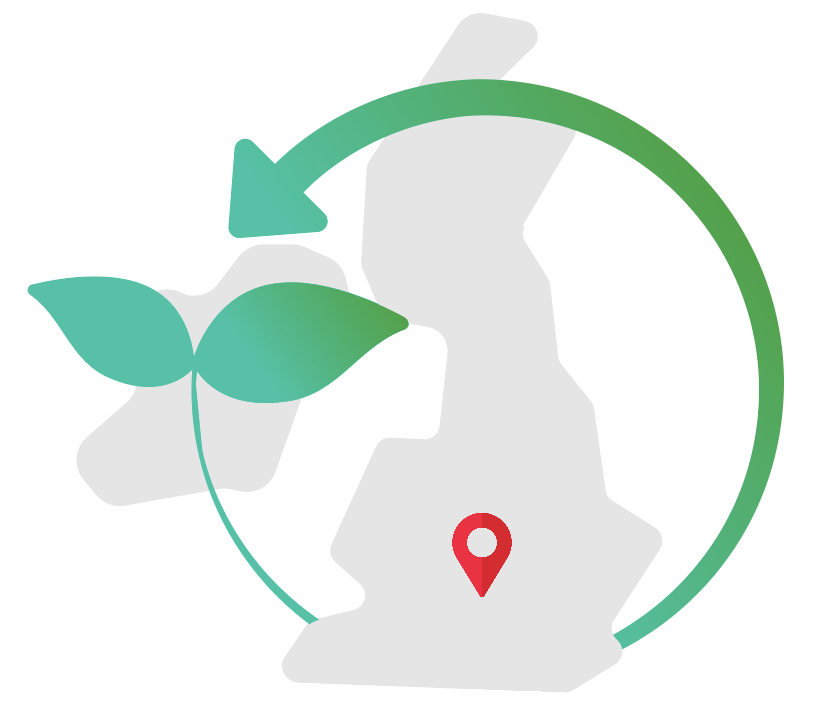
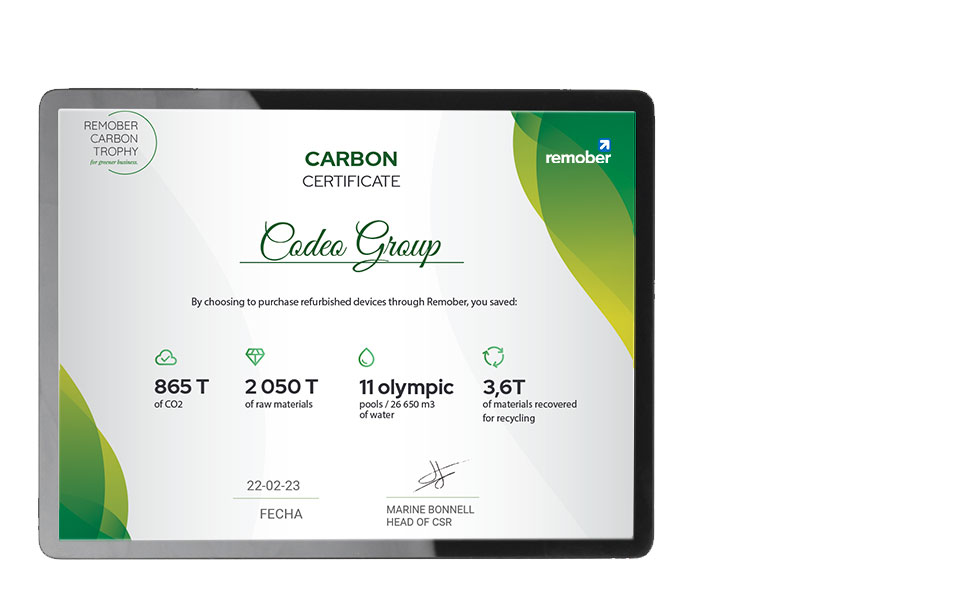
Promote your sustainable digital approach
We optimise your CSR balance sheet by integrating the tonnes of CO2 and litres of water saved, as well as the hours of work reintegrating disabled people into the workforce, depending on the options chosen.
To enhance the value of your re-use initiatives, Remober will provide you on request with a detailed statement of the eco-benefits generated by your fleet maintenance operations, purchases of refurbished smartphones or IT fleet takeovers.
Since its creation, Remober has been committed to improving and standardising professional IT equipment reuse practices in order to establish market rules, promote “Made in UK” reuse and define a quality benchmark! To achieve this, we can count on committed partners:
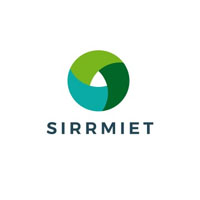
SIRRMIET
They actively work for legal changes in favour of the circular economy and the reduction of WEEE through re-use.
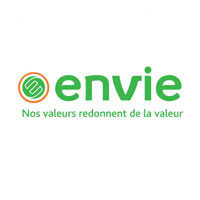
ENVIE Rhône-Alpes
Treatment and reuse of electrical and electronic equipment.
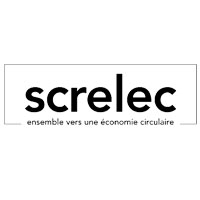
SCRELEC
Recycling of chemical products, such as batteries.
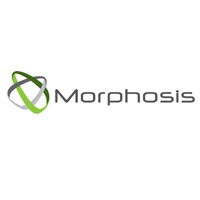
MORPHOSIS
Specialises in the extraction and refining of rare and precious metals.
FAQ
CSR and digital sustainability
WEEE recycling, carbon footprint, raising employee awareness… All the questions you’re asking about the CSR impact of your IT assets.
Green IT, also known as sustainable computing or responsible digital computing, is a set of techniques designed to reduce the social, economic and environmental footprint of digital technology.
Digital technology has a major impact on the environment, accounting for 4% of total greenhouse gas emissions and consuming 4.2% of the world’s primary energy. Practices such as taking back old equipment, maintaining IT assets and buying refurbished equipment are all part of this approach, helping to limit the carbon footprint and the production of electronic waste.
There are three main ways to reduce the digital footprint of your business IT fleet:
- Buying reconditioned equipment. In the life cycle of a device, 80% of CO2 is produced during manufacture. The purchase of refurbished equipment is an alternative to the production of new equipment and therefore represents a significant amount of CO2 avoided: on average, a smartphone refurbished by Remober represents a CO2 saving of 85% compared with new equipment.
- Computer maintenance. Repairing your faulty units rather than replacing them also avoids the production of new ones, and has an impact on your digital footprint. In addition to this aspect, maintenance helps to raise awareness among your staff of the need to extend the lifespan of equipment.
- IT asset recovery. When your equipment reaches the end of its useful life and is due to be replaced, it is often still functional. This means that, even if they no longer meet your technological requirements, they can be reused and have a second life elsewhere. Once again, this lever enables the production of new products, with all the environmental benefits that implies.
Our core business is re-use, and we do our utmost to recycle your old equipment. When devices are no longer functional or repairable, we recycle them with our partners to preserve natural resources and reintroduce them into the production cycle.
By processing and refining your old equipment, we obtain several types of metal (gold, silver, copper, etc.), as well as other clean materials (plastics, etc.) or pre-concentrated materials. In this case, Remober undertakes to provide you with a follow-up and traceability of the destruction of your equipment with a certificate of destruction by IMEI number.
Companies that own electrical and electronic equipment have obligations in terms of waste management. The European WEEE Directive (2002/96/EC) sets out a framework for waste prevention, selective collection, recycling and other forms of recovery. Companies must sort their WEEE and use an authorised collector. If WEEE contains hazardous substances, it must be covered by a hazardous waste tracking document (BSDD).
Our processes are ISO14001, ISO9001 and Weelabex certified.
Remober’s mission is to recycle as much of your old equipment as possible, because that’s where we have a real environmental impact. In fact, 80% of the carbon emissions from a new smartphone are emitted during production. By recycling your old equipment, you avoid on average almost 70% of the carbon footprint of the device’s life cycle (see diagram).
When we cannot give a second life to a device, because it is blocked (gmail, mdm, icloud account) or out of order, we make sure that it is recycled in the best conditions to revalue the components or raw materials.
Extending the lifespan of your equipment, by moving from a 3 to a 5 year product roadmap for example, offers both economic and ecological advantages. How can you do this?
- By opting for a maintenance contract for your b2b IT fleet, to systematically repair rather than replace,
- By adding reconditioned units to your fleet, to keep it together for longer,
- By choosing devices tailored to your needs.
When your equipment is no longer suited to your needs, you can extend its lifespan by taking it back: in this way, your devices can be reconditioned and given a second useful life.